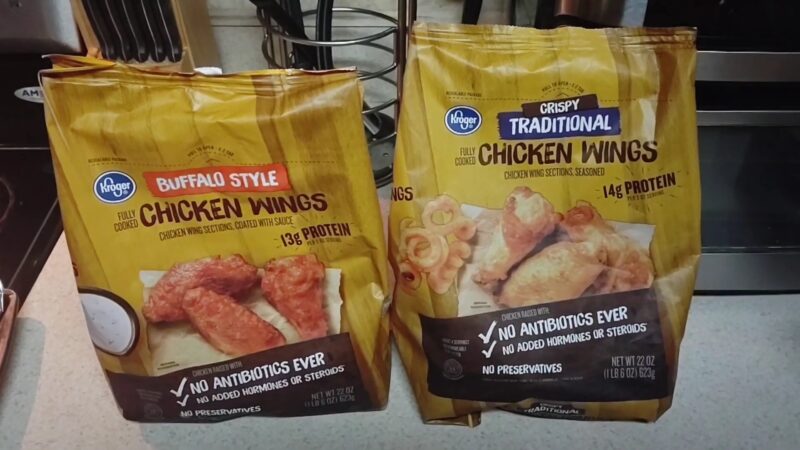In the culinary world, the debate between using fresh and frozen chicken wings is as hot as a well-spiced buffalo wing.
For both amateur cooks and seasoned chefs, understanding the nuances between fresh and frozen chicken can elevate your cooking to the next level.
In this post, I will discuss the differences, offering insights that appeal to a wide audience, from health-conscious individuals to gourmet food lovers.
Key Highlights
- Fresh chicken wings offer superior taste and texture but come at a higher price and have a shorter shelf life.
- Frozen chicken wings provide convenience and value, with minimal nutritional differences compared to fresh wings.
- Proper thawing and cooking techniques can make frozen wings nearly indistinguishable from fresh in terms of taste and texture.
- Both fresh and frozen chicken wings are nutritious and can be part of a healthy diet, serving as healthier alternatives to red meats.
- The choice between fresh and frozen wings depends on individual preferences, culinary goals, and practical considerations like budget and meal planning.
Fresh Chicken Wings

Fresh chicken wings come to us in their most natural state, never having been frozen.
Available directly in markets and now more conveniently online through services like Licious, these wings are often touted for their superior taste and texture.
Licious, for instance, guarantees premium quality by sourcing chickens raised in biosecure farms devoid of hormones or antibiotic residues.
Why Choose Fresh?
Fresh chicken wings are more likely to retain moisture, making them juicier and more flavorful. This is largely due to the steady temperature controls from farm to market.
For dishes where taste and texture are paramount, fresh chicken wings are the recommended choice, especially when you are making a family-friendly meal.
Licious takes this a step further by offering a variety of cuts, ensuring that each dish can be prepared with the most suitable type of wing, whether it be drumsticks, flats, or whole wings, delivered to your doorstep within 90-120 minutes.
Are They More Nutritious?
There’s a prevailing belief that fresh chicken is more nutritious than its frozen counterpart.
While fresh chicken does avoid some of the nutrient loss associated with the freezing process, the difference is minimal.
Both fresh and properly frozen chicken serve as healthier alternatives to red meats, providing essential proteins without the added health risks associated with higher fat content.
Frozen Chicken Wings

Frozen chicken wings are a staple in supermarkets around the globe, known for their long shelf life and convenience.
The freezing process allows these wings to be stored for months without spoiling, making them a go-to option for those looking to stock up.
The Freezing Impact
However, freezing is not without its drawbacks. The process can lead to changes in texture, making the chicken tough and chewy if not thawed correctly.
Additionally, frozen wings can suffer from cracked bones and a change in color to a less appetizing gray.
This is due to the formation of ice crystals, which can damage muscle fibers and affect the overall appearance of the chicken.
Nutrition and Safety
Contrary to some beliefs, frozen chicken does not necessarily contain preservatives. The low temperatures are enough to inhibit microbial growth.
However, some commercially frozen chicken may be injected with saline solutions to preserve flavor and add weight.
Nutrient-wise, the loss during freezing is negligible, and home-frozen chicken may only be slightly less nutritious than that frozen by suppliers, depending on the method used.
Comparison Table

| Feature | Fresh Chicken Wings | Frozen Chicken Wings |
| Taste & Texture | Juicier and more flavorful. | Can be tough if not thawed correctly. |
| Nutritional Value | Slightly more nutritious due to no freezing. | Minimal nutrient loss during freezing. |
| Convenience | Requires immediate use or refrigeration. | Can be stored for months, offering convenience. |
| Shelf Life | 1-2 days in the fridge. | Can last for months in the freezer. |
| Price | Generally more expensive. | More budget-friendly. |
| Cooking Preparation | Ready to cook or marinate immediately. | Requires thawing before cooking. |
| Environmental Impact | Higher due to the need for constant refrigeration. | Lower carbon footprint due to less frequent transportation and longer storage capability. |
| Health Risks | Lower if consumed within shelf life. | No specific risks if handled and cooked properly. |
The Thawing Debate
How you thaw frozen chicken wings can greatly affect their final texture. Thawing in warm water can prematurely cook the meat, leading to uneven cooking.
The recommended method is to thaw the wings in the refrigerator or using cold water, planning ahead to ensure they’re ready for cooking time.
Shelf Life and Safety
One of the main advantages of frozen chicken wings is their extended shelf life.
While fresh ones typically last up to five days, frozen variations can be safely stored for months.
This makes frozen wings a practical choice for those looking to minimize grocery trips or who have unpredictable schedules.
Fresh vs. Frozen: Making the Choice

When deciding between fresh and frozen chicken wings, consider your priorities. If taste, texture, and nutritional value are your top concerns, fresh variation is the way to go.
For convenience, budget, and shelf life, frozen wings offer significant advantages.
Taste Test
In blind taste tests, the difference between well-prepared fresh and frozen chicken wings can be hard to discern. The key is in the preparation.
Proper thawing and cooking techniques can minimize the textural differences, making frozen wings nearly indistinguishable from their fresh counterparts.
Cost Consideration
Generally, fresh chicken wings may cost more due to their shorter shelf life and the costs associated with keeping them chilled.
Frozen wings, being easier to store and transport, can be more budget-friendly, especially when bought in bulk.
Nutritional Differences

When it comes to nutrition, the differences between fresh and frozen chicken wings are often overestimated.
Both fresh and frozen chicken provide essential nutrients, including protein, vitamins, and minerals crucial for a balanced diet.
The belief that fresh chicken is inherently more nutritious stems from the assumption that freezing can degrade some nutrients.
However, research suggests that the nutrient loss during freezing is minimal, making the nutritional content of fresh and frozen chicken wings largely comparable.
The Role of Freezing Technology
Advancements in freezing technology have greatly reduced nutrient loss in frozen poultry.
Quick-freezing methods preserve the texture and nutritional value of chicken wings more effectively than traditional freezing.
Consequently, the gap in nutritional content between fresh and frozen chicken wings continues to narrow, reinforcing the idea that both can be part of a healthy diet.
Taste and Texture

The debate over the superiority of fresh versus frozen chicken wings often centers on taste and texture.
Fresh ones are prized for their moist, tender qualities, which are attributed to the absence of ice crystal formation that can occur in frozen ones.
On the other hand, when frozen wings are thawed and cooked correctly, many people find it challenging to distinguish them from fresh variation in blind taste tests.
Cooking Techniques Matter
The preparation method plays a critical role in mitigating the textural differences between fresh and frozen wings.
For frozen wings, proper thawing is crucial. Thawing in the refrigerator or in cold water preserves the texture and prevents the onset of precooking, which can occur if thawed in warm water.
When cooked with the right techniques, frozen chicken wings can achieve a flavor and texture that closely rivals that of fresh wings.
The Verdict: Fresh vs. Frozen

The choice between fresh and frozen chicken wings depends on individual preferences, culinary goals, and practical considerations.
Fresh wings offer unparalleled taste and texture for those willing to pay a premium and use them promptly.
Frozen wings, on the other hand, provide convenience, value, and versatility with minimal nutritional compromise.
FAQs
Can I marinate frozen chicken wings before thawing them?
No, it’s best to thaw them before marinating to ensure the flavors penetrate evenly.
How long can I keep fresh chicken wings in the fridge before they spoil?
Fresh ones should be cooked or frozen within 1 to 2 days of purchase.
Is it safe to refreeze chicken wings that have been thawed?
Yes, but only if they were thawed in the refrigerator and not at room temperature, and they should be refrozen within 24 hours.
Can I cook frozen chicken wings without thawing them first?
Yes, you can cook them directly from frozen, but adjust cooking times accordingly, as it will take longer.
Are there any specific health risks associated with consuming frozen chicken wings?
No specific health risks are associated with them, provided they are handled, thawed, and cooked properly.
Do fresh chicken wings taste better than frozen ones when cooked in a sauce?
Taste can be subjective, but many find that once cooked in a sauce, the difference in taste between fresh and frozen wings is minimal.
Final Words
The choice between fresh and frozen chicken wings doesn’t have to be a dilemma.
Both options have their place in the kitchen, depending on your needs, preferences, and the specific requirements of the dish you’re preparing.
Whether you opt for the freshness and quality of Licious chicken wings or the convenience and longevity of frozen options, the key to delicious chicken wings lies in the preparation.
Embrace the diversity of choices available and let your culinary creativity soar.

